Beef ribs are divided into two major groups. The short ribs and back ribs. The short ribs are further grouped into chuck short ribs and plate short ribs. Plate short ribs are a personal favorite since they are very tender when smoked.
As a seasoned pit master for eight years running, I have noticed that beef ribs have gained popularity as a barbeque option. That said, a lot of people are usually unsure which cut is best for their recipe but are certain of the results they want.
So I decided to put together this detailed article, to answer these questions and explain the different cutting methods. Get to know the differences between pork and beef ribs and enjoy any of my favorite go-to recipes suited for the different types of beef ribs.
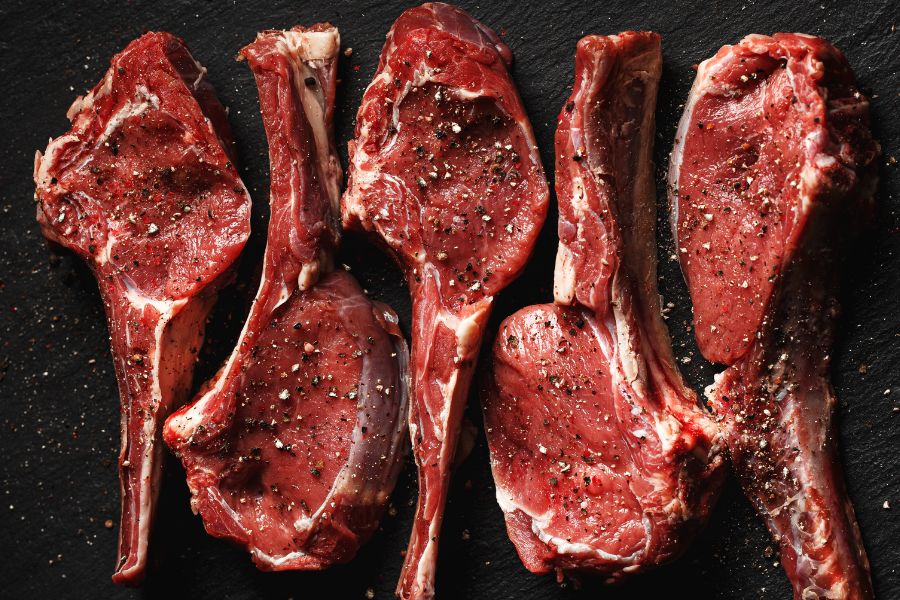
A steer has a total of 26 ribs. With 13 ribs on either side, it is easy to see how big a space the ribs take up on a carcass.
You may have even heard beef ribs referred to as a “brisket on a stick”. Some of the beef rib cuts have an enormous amount of meat on each bone while others do not.
Beef ribs deserve an honorary mention when it comes to diverse characteristics. They are divided into two based on where they are cut from.
They are the short ribs and back ribs. Where your cut comes from determines its taste and texture. It also dictates the method of cooking that will give you the best results.
Butchers break down a cow into eight primal cuts. Among them is the rib primal cut.
The rib primal cut is located towards the forequarter of the steer where the muscles generally don’t get much exercise resulting in rich, fatty marbling.
The rib eye steak and prime rib are what we call the sub-primal cuts of the rib primal.
This section is where your butcher will get the short ribs from.
These are short pieces of rib bone covered with meat. They come from the chuck, plate, brisket, or, rib portion of the cow. They have more meat on the bone than all other varieties of ribs.
Short ribs have a high-fat content, making them great for slow-cooking methods like smoking, grilling, and barbecues.
Beef short ribs are easily confused with bison short ribs due to their similar build of the animals. Beef short ribs are further divided into two. That’s plate short ribs and chuck short ribs.
Plate short ribs, also known as loaded beef ribs come from the lower section of the steer’s ribs called the short plate.
Plate short ribs are made of three meaty, juicy rib bones that can weigh up to three pounds. They are comprised of ribs 6, 7, and 8.
The short plate lies between the shank and the flank steak cuts.
Short plate ribs are located beneath the rib-eye.
The serratus ventralis muscle defines the area where the plate short ribs come from on the steer carcass. This muscle originates near the second rib and covers a majority of the rib cage.
This muscle gives plate short ribs a rich marbling exterior fat cover that pairs well with wood smoke flavor. They are perfect for grilling and smoking.
They are meatier than chuck ribs and have generous marbling throughout the cut making them perfect to cook low and slow. This cooking method ensures the fat renders without drying out the meat.
As you approach the chuck area, the serratus ventralis is much thicker and as you move toward the rump, it becomes less dense and may not cover the rib entirely.
Related Reading
Plate short ribs are hard to come by at the grocery store but you can get them at your local butcher shop. They are also commonly sold as single pieces.
Plate short ribs are also referred to as short plate ribs.
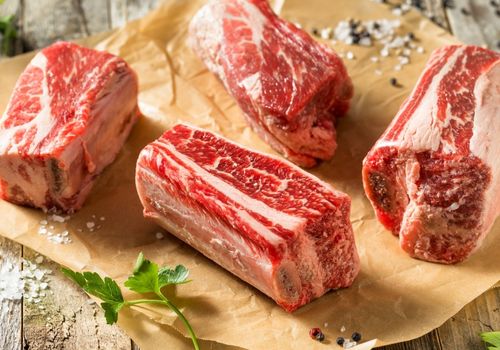
Chuck short ribs are comprised of the first five ribs of the steer.
Chuck short ribs, also known as dinosaur ribs, cover the area right underneath the chuck area of the steer. The chuck sits above both the brisket and the shank.
Chuck short ribs are normally sold as five slabs of bone or sliced up into individual bones.
The go-to muscle here is known as the latissimus dorsi muscle. This muscle is separated from the serratus ventralis by a layer of fat. It generally covers the chuck and the upper area of the plate. Chuck short ribs have slightly smaller bones than plate ribs.
Chuck short ribs are cut between three to six inches long with a rectangular chunk of meat on the bone.
Chuck ribs have a good balance of meat and fat and are full of flavor which just like plate short ribs, is great for low and slow cooking.
Back ribs come from the top dorsal area of the steer towards the spine. They are slightly curved and approximately eight inches long.
Beef back ribs have a lot less meat on them except for the intercostal meat because most of the meat in this region goes to the ribeye, famed for the ribeye steak and the prime rib.
The prime rib cut is the most elite beef cut there is. It is also known as the standing rib roast. It is juicy with a rich texture and a superior beef flavor.
The prime rib is a cut of seven rib bones attached. It is harder to find and more highly-priced than other beef cuts. It is mainly served as prime rib roast because it yields very tender results.
That said, beef back ribs are full of bone marrow content which makes them the perfect suited to stews, soups, and braising recipes. When cooked properly, they can be very tender.
Beef back ribs are smaller and leaner than other types of beef ribs. This allows them to cook faster.
Beef back ribs are fairly cheap.
From ribs nine through twelve, the serratus ventralis muscle is too thin to create a true short rib. It has very little meat on the bones. This meat here is usually turned into a royal short rib or is stripped from the bone to make ground beef for burgers and sausages.
Related Reading
There are two main cutting styles for beef rib. They can either be cut between or parallel to the bone, which is English style or across the bone, which is flanken style.
English-cut short ribs are also called barbecue ribs or fancy-cut ribs.
Flanken-cut short ribs are also known as kosher ribs, Korean-style ribs, and also crosscut ribs.
For an English cut, the butcher will separate the ribs, leaving a thick piece of meat on top of the bone. It is also attached to a membrane that you can peel off before cooking.
Different types of beef ribs cut in English style can have different looks based on how different butchers cut the ribs. There are different variations of English-style cut short ribs. Let’s check them out.
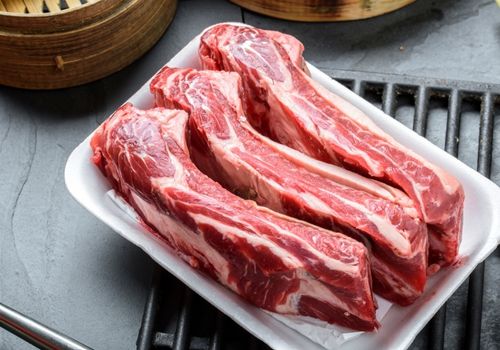
This refers to the plain English cut where all the meat and fat remain on top of the bone. The meat and fat content on short plate ribs and chuck ribs make them a good candidate for this cut.
For a trimmed English short rib cut, your butcher will cut off some of the fat and peel off the latissimus dorsi muscle. This cut is common with chuck ribs.
The English short rib cut is much like the trimmed style, but the butcher removes almost all of the fat.
For riblets, the butcher slices the bones into individual pieces before cutting around two-inch long bones topped with meat.
For a boneless cut, butchers remove as much meat as possible from the rib bones. This cut is common on plate ribs. It is also cut on chuck short ribs.
Flanken-cut ribs or flanken ribs have about half an inch thick of meat running across four to five bones. It is popular in Korean cooking of their barbecued short ribs called, Korean Kalbi.
Related Reading
Both beef and pork ribs are favorite barbecue items for many. They are the perfect addition to a warm afternoon with drinks surrounded by family and friends.
They can be cooked in different ways and flavored with a variety of ingredients to suit your preference but how do they differ from each other? Here are a few key variations.
Beef ribs are eight to twelve inches long and are measured in pounds while pork ribs are mostly three to six inches long and measured in ounces.
All beef rib cuts will be bigger and meatier than pork rib cuts.
It is often challenging to prepare beef ribs because of their large size. Most cuts of beef ribs are usually cut into more manageable sizes that can easily fit most grills, unlike pork ribs that can be cooked uncut.
Different cuts of both beef ribs and pork have distinct flavors. Beef ribs generally have a complex and rich flavor while pork ribs are very tender, savory, and juicy due to their fat content.
That said, the best cut for you depends on what your recipe calls for. Short ribs are meaty and packed with beef flavor while back ribs are preferred for their stronger aroma. If your cooking method calls, for high-fat content, then you will be better served by spare ribs cut from the pig’s belly.
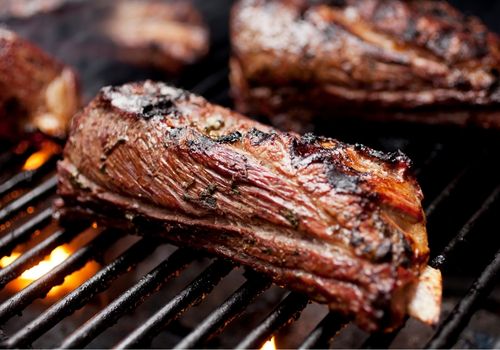
Both ribs vary largely in their cuts. Beef ribs as earlier mentioned, are either short or back ribs.
Below are the different types of pork cuts:
It is cut from the highest point of the pig’s rib cage. It is also known as loin back ribs because they are cut from near the spine from the upper loin area.
Spare ribs are cut from further down the belly area of the pig and reach toward the breastbone. They are also called side ribs.
These are spare ribs that have been trimmed and stripped of any cartilage. St. Louis ribs are the preferred cut in competition circuits since they are very neat, making them suitable for presentation.
These are the small bones and cartilage left over after the St. Louise ribs have been cut.
Beef short ribs are highly priced and generally harder to find. Baby ribs on the other hand are available in most grocery stores and are more affordable.
Beef ribs have less fat compared to pork ribs. Beef ribs have a lot of meat on the bone as well as rich marbling from the gelatinous fat running throughout the meat.
This fat gives the beef its intense flavor and acts as a meat tenderizer when the beef ribs are marinated and cooked.
It is important to note that beef ribs also have more connective tissue than pork ribs. This means that for tender results, you have to give it enough time for the connective tissue to be broken down without drying out the beef.
Related Reading
The type of beef ribs you should go for depends on the results you hope to achieve. Different types of ribs have different textures and tastes suited to different cooking methods that will largely influence the final taste.
Here are my two most reliable recipes that pair well with both short ribs and back ribs.
This is great with both plate short ribs and chuck short ribs. This 3-2-1 method cooks the ribs low and slow till tender. It goes like this:
Related Reading
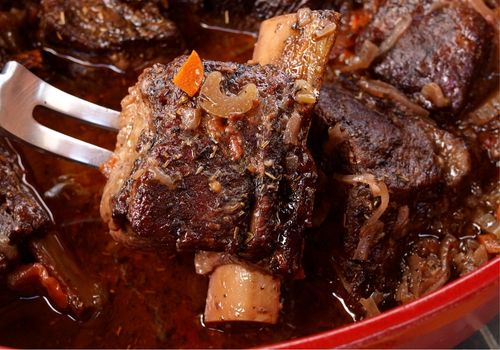
Back ribs were made for braising. Since the rib meat is limited on this cut, let’s make the most out of the flavor of the bones. Heating the ribs slowly with oil and moisture in a sealed heavy bottom pan will tenderize the meat while optimizing the taste.
As a bonus, you also end up with a great sauce loaded with beef flavor from the bones. Let’s get started.
With beef ribs, pick the one that best matches your recipe. Both types of beef ribs can yield very tasty results for you and your family to enjoy when cooked right.